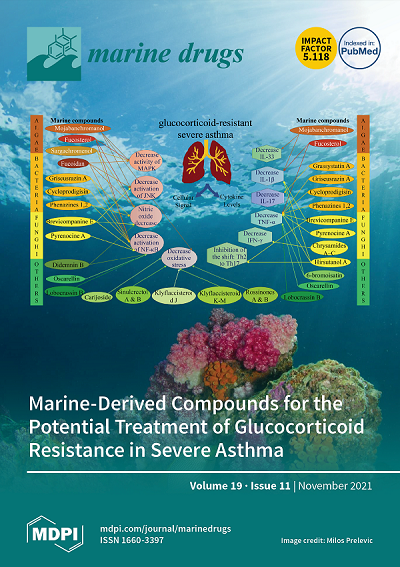优化抗氧化潜力:基于因子设计的褐藻糖胶和没食子酸共轭葡聚糖混合物配方
IF 4.9
2区 医学
Q1 CHEMISTRY, MEDICINAL
引用次数: 0
摘要
由于氧化应激与心血管疾病、神经退行性疾病、癌症和其他疾病有关,氧化应激在健康和稳态中的作用引起了科学界的兴趣。因此,大量研究试图找出新的外源性抗氧化化合物作为补充。多糖具有公认的抗氧化特性。然而,为了增强这些特性,通常需要对多糖进行化学修饰。因此,将右旋糖酐与没食子酸(Dex-Gal)共轭,然后与褐藻糖胶 A(FucA)结合,配制成混合物,旨在获得比单个多糖更优越的抗氧化活性。采用因子设计将 FucA 和 Dex-Gal 按不同比例进行组合,产生了五种混合物(BLD1、BLD2、BLD3、BLD4 和 BLD5)。通过分析体外抗氧化测试的表面图,包括总抗氧化能力(TAC)、还原力和羟基自由基清除能力,最终选择 BLD4 作为最佳配方。在过氧化氢诱导的各种氧化应激条件下对 3T3 成纤维细胞进行的测试表明,BLD4 提供的保护能力比其分离成分更强。由 Dex-Gal 和 FucA 组合而成的 BLD4 配方显示出作为抗氧化剂策略的前景,其性能优于其单独成分,并表明它有可能作为一种补充剂,在不利的健康条件下减轻氧化应激。本文章由计算机程序翻译,如有差异,请以英文原文为准。
Optimizing Antioxidant Potential: Factorial Design-Based Formulation of Fucoidan and Gallic Acid-Conjugated Dextran Blends
The role of oxidative stress in health and homeostasis has generated interest in the scientific community due to its association with cardiovascular and neurodegenerative diseases, cancer, and other diseases. Therefore, extensive research seeks to identify new exogenous antioxidant compounds for supplementation. Polysaccharides are recognized for their antioxidant properties. However, polysaccharide chemical modifications are often necessary to enhance these properties. Therefore, dextran was conjugated with gallic acid (Dex-Gal) and later combined with fucoidan A (FucA) to formulate blends aimed at achieving superior antioxidant activity compared to individual polysaccharides. A factorial design was employed to combine FucA and Dex-Gal in different proportions, resulting in five blends (BLD1, BLD2, BLD3, BLD4, and BLD5). An analysis of surface graphs from in vitro antioxidant tests, including total antioxidant capacity (TAC), reducing power, and hydroxyl radical scavenging, guided the selection of BLD4 as the optimal formulation. Tests on 3T3 fibroblasts under various conditions of oxidative stress induced by hydrogen peroxide revealed that BLD4 provided enhanced protection compared to its isolated components. The BLD4 formulation, resulting from the combination of Dex-Gal and FucA, showed promise as an antioxidant strategy, outperforming its individual components and suggesting its potential as a supplement to mitigate oxidative stress in adverse health conditions.
求助全文
通过发布文献求助,成功后即可免费获取论文全文。
去求助
来源期刊

Marine Drugs
医学-医药化学
CiteScore
9.60
自引率
14.80%
发文量
671
审稿时长
1 months
期刊介绍:
Marine Drugs (ISSN 1660-3397) publishes reviews, regular research papers and short notes on the research, development and production of drugs from the sea. Our aim is to encourage scientists to publish their experimental and theoretical research in as much detail as possible, particularly synthetic procedures and characterization information for bioactive compounds. There is no restriction on the length of the experimental section.
 求助内容:
求助内容: 应助结果提醒方式:
应助结果提醒方式:


